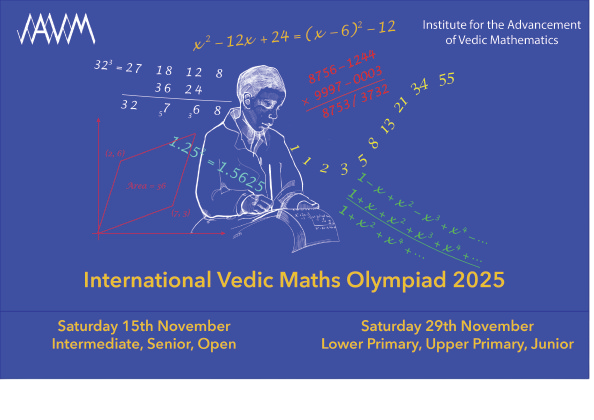FOR PARTICIPANTS
International Vedic Mathematics Olympiad
IVMO 2025
Are you a school/college/institution or an individual planning to host the IVMO Olympiad?
Registration Fee : $6
Last date to register : November 07, 2025


Enhances Speed

Develops Strategic Thinking

Improves Creative Thinking
Vedic learners solve mathematical calculations in double-quick time

How fast you can solve this?
846 x 997
Your time
00:00
Syllabus Coverage
The lists are accumulative. At each level topics from previous levels are included. For example, for Intermediate level, all topics in Primary and Junior are relevant

LOWER PRIMARY AND UPPER PRIMARY
9 & 11 Years & Under
- Four rules of number + – x ÷
- Four rules of simple fractions + – x ÷
- *Four rules of decimals + – x ÷
- Divisibility by 2, 4, 8, 5, 10, 3, 6, 9
- Digital roots and division by 9
- Multiplication and division by 5, 25, 50
- Nikhilam multiplication
- Squaring two-digit numbers ending in 5
- Multiplication of the final digits add to 10
- Vertically and crosswise multiplication
- Patterns and sequences
- Area and perimeter of simple shapes
- *Primes, squares, and triangular numbers
- Money
- Word Problems involving all the above
- *Not included in Lower Primary

JUNIOR
13 Years & Under
- Four rules of mixed number + – x ÷
- Decimal to fraction conversions
- Squaring numbers close to a base
- Use of vinculums (bar numbers)
- Nikhilam division
- Paravartya division
- Straight division with 2-digit divisors
- Percentages
- Direct and Indirect proportion
- HCF and LCM by Vertically and crosswise
- nth term formulae for linear sequences
- Mean, median, mode
- Simple rules of indices
- Linear equations
- Area and circumference of a circle
- Angles in parallel lines and quadrilaterals
- Volume and surface area (cuboids)

INTERMEDIATE
16 Years & Under
- Converting denominators ending in 9
- Conversion of partially recurring decimals
- Straight division with 3-digit divisors
- Simultaneous equations
- Quadratic equations
- Nth term for quadratic sequences
- Completing the square
- Difference of two square
- Cubing 2-digit numbers
- Combined ratios
- Polynomial division with binomial divisors
- Polynomial multiplication
- Factor theorem
- Indices including fractional and negative
- Using last digits to check answers
- Angles in polygons
- Equation of straight lines
- Similar areas and volumes

SENIOR
18 Years & Under
- Coefficients in polynomial products
- Using first and last terms in polynomials
- Series expansions of binomials
- Applications of discriminats of quadratics
- Divisibility using Osculation
- Logs and Exponential functions
- Inverse functions
- Partial fractions
- Method of differences
- Product and Quotient rules
- Chain rule
- Pythagorean triples
- Addition and subtraction of angles
- Geometric problems involving triples
- Areas of shapes on coordinate axes
- Integration to find areas
- Equation of circles

OPEN
For Any Age Group
- Coefficients in polynomial products
- Using first and last terms in polynomials
- Series expansions of binomials
- Applications of discriminats of quadratics
- Divisibility using Osculation
- Logs and Exponential functions
- Inverse functions
- Partial fractions
- Method of differences
- Product and Quotient rules
- Chain rule
- Pythagorean triples
- Addition and subtraction of angles
- Geometric problems involving triples
- Areas of shapes on coordinate axes
- Integration to find areas
- Equation of circles

LOWER PRIMARY AND UPPER PRIMARY
9 & 11 Years & Under
-
- All from 9 and the last from 10
- Vertically and crosswise
- By one more than the one before
- By the last digits
- By addition and subtraction
- By observation

JUNIOR
13 Years & Under
- Deficiency
- Transpose and adjust
- On the flag
- By elimination and retention
- All the multipliers
- Proportionately

INTERMEDIATE
16 Years & Under
- By completion and non-completion
- Particular and general
- Products of means. Product of extremes

SENIOR
18 Years & Under
- First by the first and last by the last
- Product/sum, Sum/product
- Differential calculus
- Osculation

OPEN
For Any Age Group
- First by the first and last by the last
- Product/sum, Sum/product
- Differential calculus
- Osculation
Registration closed
Participate & Win Certificates

Register as a participant
Pay registration fee online or offline to centre coordinator.

Connect with centre coordinator
Take the guidance/trainings offered to excel.

Participate in the Olympiad & win!
Take part in the 1hr online test and see how fast you perform!

At each level the top 60% of scores will be awarded gold, silver, and bronze certificates in the ratio 1:2:3. The top three internationally will also receive special certificates.
Frequently Asked Questions
Can I sit IVMO on any date, 15th, or 29th November 2025?
Can I sit any time on the day of my test?
How long is the Olympiad?
Which level should I enter?
Can I enter a level above my age?
Yes. For example, if you are 12 years of age you can enter any IVMO except Primary.
Can I get a list of topics?
Yes, they are available here.
Can I see past papers or sample papers?
Yes, these are available for download here.
How can I learn the Vedic Maths techniques?
Contact your Centre Coordinator who may be able to give lessons. VM learning resources are now available on IAVM shop and Youtube channel.

